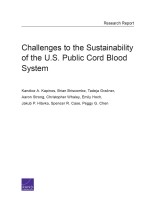| 来源类型 | Research Reports
|
| 规范类型 | 报告
|
| DOI | https://doi.org/10.7249/RR1898
|
| ISBN | 9781977400000
|
| 来源ID | RR-1898-DHHS
|
| Challenges to the Sustainability of the U.S. Public Cord Blood System |
| Kandice A. Kapinos; Brian Briscombe; Tadeja Gracner; Aaron Strong; Christopher Whaley; Emily Hoch; Jakub P. Hlavka; Spencer R. Case; Peggy G. Chen
|
| 发表日期 | 2017
|
| 出版年 | 2017
|
| 页码 | 156
|
| 语种 | 英语
|
| 结论 |
Demand Has Stagnated, Costs and Competition Have Increased- The national program has significantly increased the publicly available inventory, but the proportion of HSC transplants using cord blood has been declining from about 12 percent of all HSC transplants to about 8 percent from 2010 to 2015.
- Obtaining higher–TNC count units increases costs because CBBs have to collect more units to get a useable or bankable unit. Banks lose money on the collection of low–TNC count units, however, as they are very unlikely to be used.
- Domestic and international CBBs are competing, and the number of U.S. CBBs and their inventories continue to grow. If the number of CBBs and CBUs rises while demand remains stagnant or falls, CBBs will face financial pressure.
Relative Clinical Effectiveness Remains Unclear- Some interviewees said that CBUs are used only as a last resort, whereas others mentioned a preference for CBUs, particularly for certain types of patients. Thus, any comparison of patients using different HSC sources suffers from a significant selection bias.
- The majority of the literature follows patients for only a short time period. Because cord blood transplants take longer to engraft, such a truncation will bias results toward more-favorable outcomes for other sources.
- Higher–TNC count CBUs have been shown to offset some amount of genetic mismatching, which is important for minorities.
Cord Blood Transplantation Is Not a Panacea Treatment, But Has Significant Societal Value- We estimated the annual societal benefit of having a national inventory to be around $1.7 billion relative to an annual cost of maintaining the inventory at about $60–70 million.
- CBUs are not the answer for every patient, but their availability is crucial for hundreds of patients every year who have no alternative, especially for pediatric and minority patients.
- Access for minorities can be increased by incentivizing banks to collect more minority units or to collect larger CBUs from all donors.
|
| 摘要 |
National Cord Blood Inventory (NCBI) Program- HRSA should focus on efforts to increase the diversity of the national inventory by (1) providing funding that encourages banks to either add collection sites where more minority cord blood units (CBUs) can be collected, or increase subsidies for minority units, and (2) considering increasing the minimum total nucleated cell (TNC)–count threshold, especially for nonminority units. HRSA should also explore ways in which CBBs might specialize in the collection of different types of CBUs.
- HRSA should consider the trade-offs between increasing the TNC-count threshold and revising the way in which subsidies are paid in conjunction with program objectives and modify the program so that CBB efforts better align with program goals. There are advantages and disadvantages to each approach, but the current system incentivizes the banking of lower–TNC count units despite these units being the least profitable for banks and the least likely to be used by patients.
- HSRA should standardize and consistently fund NCBI contracts to the extent possible. The uncertainty both in how the contracts will be funded and in the frequency of funding results in market instability.
Public Cord Blood Banking- Stakeholders can work together to strengthen different aspects of the industry by making changes to payment, research funding, and knowledge sharing. We found a strong societal benefit to banking cord blood — quantified annually at about 2.5 times the cost of maintaining the system — and, as a result, we recommend continued federal support for cord blood stem cell research. The advantages for sharing knowledge in the industry include avoiding the loss of all clinical and technical knowledge specific to cord blood and cord blood transplantation.
|
| 主题 | Biomedical Research
; Health Economics
; Maternal Health
; Minority Populations
; Pediatric Medicine
|
| URL | https://www.rand.org/pubs/research_reports/RR1898.html
|
| 来源智库 | RAND Corporation (United States)
|
| 引用统计 |
|
| 资源类型 | 智库出版物
|
| 条目标识符 | http://119.78.100.153/handle/2XGU8XDN/108580
|
推荐引用方式
GB/T 7714 |
Kandice A. Kapinos,Brian Briscombe,Tadeja Gracner,et al. Challenges to the Sustainability of the U.S. Public Cord Blood System. 2017.
|
|
文件名:
|
x1506616695701.jpg
|
|
格式:
|
JPEG
|

|
文件名:
|
RAND_RR1898.pdf
|
|
格式:
|
Adobe PDF
|
除非特别说明,本系统中所有内容都受版权保护,并保留所有权利。